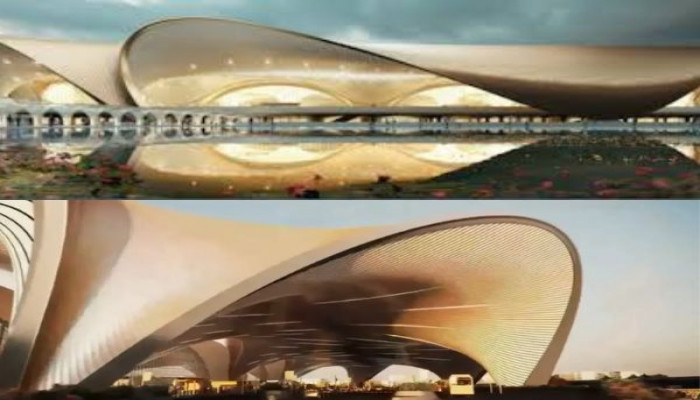Navi Mumbai International Airport to become India’s first multimodal transport hub
- In Reports
- 07:59 PM, Apr 23, 2025
- Myind Staff
The upcoming Navi Mumbai International Airport (NMIA) in Panvel will be India's first airport to provide inter-modal connectivity. Scheduled for the commissioning of Phase I and II in June 2025, the greenfield airport is expected to begin commercial operation towards the latter half of this year. Upon completion, NMIA will develop through highways, metro, suburban rail, monorails, sky trains, hovercrafts, etc., and would serve as a model for transport infrastructure.
NMIA is in Panvel, giving it highway access from three sides, with direct metro services to Mumbai's Chhatrapati Shivaji Maharaj International Airport (CSMIA). Suburban railway lines will also serve this airport. Apart from that, there will be hovercraft services as well as monorail and sky train connectivity for reaching different locations in the Mumbai Metropolitan Region (MMR).
The new airport will greatly improve regional and interstate travel. The airport will be connected on three sides by highways and will also have metro and suburban rail links, including airport-to-airport metro services. Construction of one terminal and a single runway in the first two phases is planned with an initial capacity to handle 2 crore passengers per annum. Further phases will add 4 terminals and a second runway, increasing capacity to about 9 crore passengers per annum.
Road Access and Projects
Currently, the airport has only road access. However, with the completion of the Mumbai Trans Harbour Link (MTHL) or Atal Setu Nhava Sheva Sea Link, connectivity from South Mumbai has improved. Using the exits at Ulwe or Panvel, the airport is just an hour away.
The Ulwe Coastal Road built a cost of Rs 1,590 crore, is one of the major ongoing infrastructural projects. This 6.7-km-long, six-lane road connects Amra Marg with Atal Setu junction at Shivajinagar, continuing directly into the airport. The construction work done so far is about 40% of the whole work, which is likely to be ready for operational use by 2026. This will also have a 0.93-km elevated airport link flying over major railway lines and roads.
Kalamboli is located at the link of five prominent highways including the NH-4 and is being given a facelift for signal-free access to NMIA and Jawaharlal Nehru Port Trust (JNPT). A Rs 500 crore two-level interchange is being developed. The project includes 5 km of roads in five directions, seven flyovers of 3 km, and 2 underpasses. The completion date of this project is expected to be within 18 months.
Other access routes include the Sion-Panvel Highway and Palm Beach Road from South and West Mumbai. Upgradation of NH66, connecting Panvel to Goa, is also under construction by which accessibility from Konkan regions such as Mahad, Ratnagiri and Goa would be provided to NMIA.
NH348, referred to as the JNPT Road, has been upgraded to a 6-lane access-controlled expressway. A 28 kilometers of road, from Palaspe to Airport via Kalamboli, will put cargo and passenger vehicles on the fast track to reaching NMIA in 10-15 minutes after the complete interchange is finished.
Rail and Metro
Panvel railway station is being developed as a main terminal for long-distance trains. It is already well connected with Gujarat and Konkan. Completion is almost done for Rs 2,782 crore Panvel-Karjat suburban rail corridor of Mumbai Railway Vikas Corporation (MRVC). This corridor is expected to start operations in December.
Suburban Belapur/Nerul-Kharkopar-uran line has also provided access to the airport through its 27 km 'fourth corridor' with Targhar station set to become a major rail linkage to the airport. Future plans include direct monorail, skytrain and metro services from CST, Thane, and Kalyan. The proposed CST-Panvel elevated rail link will further strengthen this entire network.
The state authorities are fast-tracking metro connectivity. The Navi Mumbai Airport Express Line Metro, developed by City and Industrial Development Corporation of Maharashtra Ltd (CIDCO), will connect NMIA to Chhatrapati Shivaji Maharaj International Airport (CSMIA) over a distance of 34 km, out of which 25.8 km will be elevated and 8.2 km underground. It will have a total of 20 stations, comprising 14 elevated and 6 underground.
The airport will connect directly to Mumbai Metro Lines 2D, 8, and also the Navi Mumbai-Pendhar-Belapur-Taloja Metro line. More metro corridors connecting NMIA from the eastern side are expected to come up, including a corridor from Taloja to Khandeshwar.
Metro Line 8 comprises a Rs 15,000-crore project, which is a CIDCO and Mumbai Metropolitan Regional Development Authority (MMRDA) joint venture. The 11.1-km stretch from CSMIA to Mankhurd will be constructed with the assistance of Delhi Metro Rail Corporation (DMRC), while CIDCO will construct the Mankhurd-NMIA segment. This line is expected to serve 22.7 lakh passengers daily by 2061, with a peak hour load of 37,000 commuters.
Water Transport
Maharashtra will soon start a water taxi service across MMR to ease road traffic and pollution. Hovercrafts will come from Colaba, while cargo ferries will commence from Raigad to provide fast accessibility to NMIA and cut travel time to just about 20 minutes from South Mumbai.
The Mumbai-Hyderabad High-Speed Rail (MHHSR) will be established within a stretch of more than 750 km in less than four hours and is expected to have a station nearest to the airport. NMIA's added connectivity will extend thousands of miles across Maharashtra and Telangana through this bullet train link.







Comments